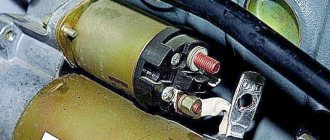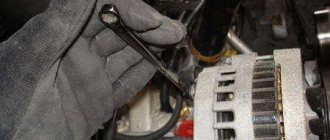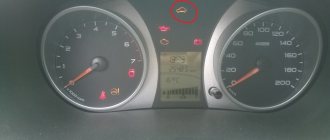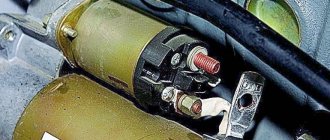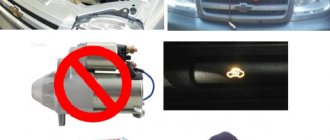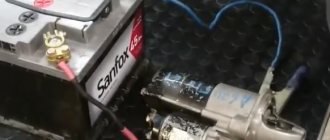VAZ 2109 won't start
What to do if your beloved VAZ 2108 2109 21099 refuses to start? This article will discuss a troubleshooting diagram. As you probably know, for the engine to start and run, three conditions are necessary: air, gasoline, spark. When the engine crankshaft rotates, a combustible mixture is sucked into the cylinders (a mixture of air and gasoline in a certain proportion). After closing the intake and exhaust valves at the end of the compression stroke, a spark should appear on the spark plug, igniting the combustible mixture - the engine starts. Let's consider the diagnostics of identifying a fault along the chain. The entire methodology is reflected in detail in the figure; the text provides the necessary comments on the points.
Troubleshooting algorithm
1) If the starter does not turn the crankshaft of the engine number nine, then check the following: the battery must be charged, when you turn the ignition key you should hear a click of the solenoid relay operating, all connectors must be connected to the starter.
2) If the starter rotates the crankshaft, then it is necessary to determine whether a flammable mixture or a spark is entering the cylinder. First we look for a spark. To do this, remove the high-voltage wire from any spark plug, bring it at a distance of a centimeter to the ground and turn the starter.
3) If there is no spark going to the spark plug, check whether the spark is going to the ignition distributor (distributor). To do this, remove the central wire from the distributor, bring it to ground at a distance of 1 cm and turn the starter. If a spark jumps from the wire to ground, the problem is in the ignition distributor: check the slider, clean the contacts.
Checking the spark from the ignition coil
4) If there is no spark to the ignition distributor, then diagnostics of the ignition system is necessary. There are two options for further troubleshooting: A) Using a non-contact ignition system diagnostic device. B) Manual fault detection. A) You have a device, their varieties may be different, but the principle of operation is the same: power supply and operation of the Hall sensor and switch are displayed by lights.
Diagnostic device for non-contact ignition system
The device is connected to the open circuit of the switch. Remove the connector from the switch and connect it to the device connector. Place the second connector of the device on the switch. Turn on the ignition: the ignition system power light and the Hall sensor power light should be on.
When the Zhiguli starter rotates, the following should blink: the switch control light, the pulse light from the Hall sensor. If the switch control light does not blink, replace the switch.
If there are no pulses from the Hall sensor, disassemble the ignition distributor and make sure that the distributor runner rotates when the starter rotates. If the starter turns, but the distributor runner does not, the timing belt is broken. If the slider rotates but there is no signal from the Hall sensor, replace the Hall sensor. B) Option for troubleshooting without an ignition diagnostic tool. Disassemble the ignition distributor and make sure that the distributor slider rotates when the starter rotates. If it doesn't turn, the timing belt is broken. If the slider rotates, check that the distributor drum does not touch the Hall sensor. Make sure the wires and connector of the Hall sensor are in good condition. If everything is normal, change the switch; the most common reason when there is no spark is the switch burned out. If, even after replacing the switch, a spark does not appear, suspicion falls on the ignition coil and connecting wires. The ignition coil (in popular parlance) fails extremely rarely, but such cases also happen.
5) If there is a spark, but the engine does not start, remove the air filter cover.
Air filter without cover
Is the filter clean and free of oil? We try to start it without the air filter cover, if it starts, it means there is no air access to the carburetor, the filter is clogged, the air supply is filled with oil. 6) If it doesn’t start, completely remove the filter with the cap and unscrew the fuel hose from the fuel pump to the carburetor on the carburetor side. We turn the starter - gasoline should spray out. Doesn't it splash? Either the fuel pump has failed, or fuel is not supplied from the tank, if there is any there, of course. 7) If gasoline splashes when the starter rotates, unscrew the fuel return hose from the carburetor. Plug the return with your finger and blow into the supply with your mouth. Is air passing into the float chamber? If yes, then gasoline is also passing through, you need to blow out the entire carburetor with compressed air. Is there air getting into the float chamber? Check the carburetor mesh filter. We unscrew it and clean it. Did not help? — The needle valve may be stuck. Tap the side of the carburetor with a wrench or blow compressed air into the feed hole. 9) If you still cannot blow air into the float chamber, remove the carburetor cover. We take it in our hands and try to blow it again. Air does not pass through - change the needle valve. 10) If air flows through when the cover is removed, but not when it is clamped on the carburetor, the fuel jets are clogged. The carburetor needs to be completely purged. 11) If after the work done the car still does not start, unscrew the spark plugs. Look, are they filled with gasoline or not? If they are flooded, you need to dry them. Turn on the gas stove and, holding the pliers, dry the candle over the fire. If the spark plugs are still dry, you can try spraying a few drops of gasoline into chamber 1 of the carburetor (closer to the passenger compartment). The resulting vacuum may pierce the carburetor and the engine will start.
We try to start it without the air filter cover, if it starts, it means there is no air access to the carburetor, the filter is clogged, the air supply is filled with oil. 6) If it doesn’t start, completely remove the filter with the cap and unscrew the fuel hose from the fuel pump to the carburetor on the carburetor side. We turn the starter - gasoline should spray out. Doesn't it splash? Either the fuel pump has failed, or fuel is not supplied from the tank, if there is any there, of course. 7) If gasoline splashes when the starter rotates, unscrew the fuel return hose from the carburetor. Plug the return with your finger and blow into the supply with your mouth. Is air passing into the float chamber? If yes, then gasoline is also passing through, you need to blow out the entire carburetor with compressed air. Is there air getting into the float chamber? Check the carburetor mesh filter. We unscrew it and clean it. Did not help? — The needle valve may be stuck. Tap the side of the carburetor with a wrench or blow compressed air into the feed hole. 9) If you still cannot blow air into the float chamber, remove the carburetor cover. We take it in our hands and try to blow it again. Air does not pass through - change the needle valve. 10) If air flows through when the cover is removed, but not when it is clamped on the carburetor, the fuel jets are clogged. The carburetor needs to be completely purged. 11) If after the work done the car still does not start, unscrew the spark plugs. Look, are they filled with gasoline or not? If they are flooded, you need to dry them. Turn on the gas stove and, holding the pliers, dry the candle over the fire. If the spark plugs are still dry, you can try spraying a few drops of gasoline into chamber 1 of the carburetor (closer to the passenger compartment). The resulting vacuum may pierce the carburetor and the engine will start.
The techniques described above will help you start a VAZ 2108 2109 21099 in more than 90% of cases. However, in case of problems that are difficult to diagnose (the timing belt has slipped by several teeth, poor or absent compression in the engine, the carburetor is not adjusted), only a service station can help you.
Possible reasons for absence
Most modern cars are equipped with an abundance of sensors. They make the car owner’s life easier and make repairs more difficult. In the electronics responsible for the operation of an injection engine, there are, of course, several sensors responsible for the spark formation process. However, the prerequisites for the absence of a spark (VAZ-2110, injector, 8 valves) usually occur in other components. There are a number of types of possible breakdowns. The first includes various problems in the car’s fuel system. This includes malfunctions when fuel is not allowed to enter the cylinders or the supply is malfunctioning.
If there is no spark (VAZ-2110, injector, 8 valves), then you will like it due to the fuel system. Often the pump relay or the submersible element itself burns out. The test is done by ear.
Next come the tasks related to the electronic part. These are some of the most common defects. With such breakdowns, an electronic discharge does not reach the spark plug. The mixture will not be set on fire. In the midst of global problems - a complete failure of the engine, a broken timing belt. These defects should not be dwelled upon carefully.
Carburetor engine does not start (reasons related to the ignition system)
Very often, the reason that a car engine does not start or starts and stalls is not a malfunction of the carburetor or power system, but problems with its ignition system.
If the engine does not start, in most cases it is recommended to first check the ignition system, and only then look for the problem in the carburetor. This is especially true when starting the engine in wet weather or when there is a temperature difference. Let's consider the most common reasons that a carburetor engine does not start due to a malfunction of the ignition system using the example of engine 2108 (21081, 21083) of VAZ 2108, 2109, 21099 cars and their modifications.
The easiest way to start troubleshooting is by visually inspecting the elements of the ignition system (suddenly something just jumped off somewhere) and then checking for the presence of a spark on the spark plugs (to determine whether the ignition system is working at all). And then move on to checking the armored wires, distributor cap, slider, etc.
The engine does not start or starts and stalls, reasons
— Battery is faulty
The battery could simply be dead. Its terminals or the tips of the power wires could also be oxidized. Oxidation can be removed with sandpaper, and the battery can be charged.
— Spark plugs are faulty
It is possible that the spark plug insulator is broken (current leakage to ground), or the gap between the spark plug electrodes is incorrect, or they are covered with black or oil deposits. To determine the malfunction, you need to unscrew the spark plugs and look at the carbon deposits on their electrodes. Check the gap. If the spark plug does not work at all, it may be flooded with fuel. See Spark Plug Problems. To determine the breakdown, you can perform a test by starting the engine in the dark (described in the Notes below).
Black carbon deposits on spark plugs
— High-voltage wires are connected in the wrong order
If for some reason the wires were disconnected from the spark plugs or the distributor cap, it is quite possible that they were installed back with an error. Check the order in which the wires are connected.
The procedure for connecting wires to the distributor cover on VAZ 2108, 2109, 21099
— Incorrectly set ignition timing
If the timing is too early or too late, it is quite possible that the engine will not start or will have difficulty starting and stall. We set the ignition timing using a strobe or by ear by rotating the distributor until a stable idle speed appears within 700-800 rpm. For the required advance angles and the order of their installation, see “Setting the ignition timing on carburetor engines of VAZ 2108, 2109, 21099”.
Adjusting the angle using a distributor
— High-voltage wires are faulty
High-voltage wires may have damage to the protective coating (“breakdown”). The easiest way to check it is by the presence of a glow on them by starting the engine in the dark. You can also check their resistance using a tester. In addition, during a visual inspection we identify oxidized or damaged wire tips.
Measuring the resistance of high-voltage wires
— Distributor cover is faulty
In the event of a “breakdown” of the distributor cover, it is necessary to remove it and inspect it. Traces of a “breakdown” are visible visually (dots, stripes). In addition, it is necessary to evaluate the condition of the contacts inside and outside the cover and the condition of the central contact “coal”.
— The ignition distributor (“slider”) is faulty
If the “runner” breaks down, it must also be removed and inspected. Traces of a “breakdown” are visible visually. An interference suppression resistor in the “runner” can also cause the engine to not start or to start and stall. Replace it with a piece of copper wire and restart the engine.
Ignition distributor (“slider”)
— Ignition coil is faulty
You can visually assess the condition of the ignition coil cover. Cracks in it are not allowed (especially around the central contact), as this is a sign of “breakdown”. You can check the coil more thoroughly using a tester. In case of its absence, temporary replacement with a known good one. See "Checking the Ignition Coil".
Checking the primary winding of the ignition coil
— Hall sensor is faulty
Determining the health of the Hall sensor without a voltmeter is very difficult (See “Checking the Hall sensor”). It is possible to replace it with a known good one and then restart the engine.
— The switch is faulty
Checking the serviceability of the switch without an oscilloscope is problematic. This can be done in advance using the voltmeter readings when turning the key in the ignition switch. See “Checking the switch of VAZ 2108, 2109, 21099 cars.”
Ignition system switch for VAZ 2108, 2109, 21099 cars
— Low voltage wires of the ignition system are faulty
Visually inspect the low voltage wires of the ignition system. We check for kinks, abrasions, chips that have come off or are not fully installed. We check the presence of voltage at terminal B+ of the coil and terminal 30/1 of the ignition switch. To help, you can take the “Ignition system diagram for VAZ 2108, 2109, 21099 cars.”
Diagram of the ignition system for VAZ 2108, 2109, 21099 cars
— The ignition switch is faulty
Current is supplied to the ignition system through terminals 30/1 (brown wire - current comes from the generator) and 15 (blue and black - current goes to the coil). If the contact in the block on the lock is oxidized or leaky, the ignition system will be de-energized and the engine will not start.
Notes and additions
— A preliminary check of the ignition system consists of checking the presence of a spark on the spark plugs (the unscrewed spark plug with the connected voltage wire is placed on the engine ground, the engine is cranked with the starter, the presence and strength of the spark on the spark plug is visually assessed). For more details, see “Checking the contactless ignition system of VAZ 2108, 2109, 21099 cars.”
— General check of the ignition system elements for breakdown: start the engine in the dark and visually inspect the spark plugs, armored wires, distributor cover, ignition coil. If they malfunction, sparking or glowing will be noticeable.
What to do
If the engine runs or starts poorly, motorists are interested in how to strengthen the spark on the spark plugs. First, you need to establish the cause of the breakdown by checking the previously mentioned components and elements using a multimeter and visual inspection. Many faults can be seen by eye.
Often, a simple replacement of spark plugs or glow plugs can help improve the spark (depending on the type of internal combustion engine (petrol or diesel). It is advisable to buy elements from well-known manufacturers in the mid-price category, beware of counterfeits. Faulty spark plugs can often be identified by their appearance. In addition, their replacement is required with the following symptoms:
- Engine tripping.
- Poor starting of the power plant, especially in cold or wet weather.
- White smoke from the exhaust pipe of a car with a diesel engine.
- Reduced vehicle dynamics.
- Increased fuel consumption.
Comparing spark plugs before replacing them It is worth noting that sometimes similar symptoms are observed when other parts of the car fail. Therefore, if the spark plugs visually look serviceable, it is better to check other components and elements. If you were unable to determine the cause yourself or replacing the SZ did not help, it is recommended to contact a car service for professional diagnostics.
The spark power may not be enough if the ignition coil is broken or the high-voltage wires fail. Therefore, they should be tested with a multimeter. Replacing these parts often helps improve the spark.
Checking the coil with a multimeter
Increased power is often achieved by replacing the distributor. Repairing the low voltage circuit or improving the conductivity of the connection contacts often helps solve the problem. To search for an open or short circuit, use a multimeter. Often, replacing or charging the battery with a charger helps increase spark power. Everyone knows that a weak battery does not contribute to good engine starting, especially in winter. Therefore, it must be checked before the cold weather. If it is old or poorly charged, it should be replaced or charged. Recharging may also be required after the machine has been idle for a long time.
Charging the battery using a charger
But sometimes, in order to completely get rid of the problem, you only need to modify the spark plugs yourself. This is primarily relevant for owners of used domestic cars or old inexpensive foreign cars. This method is also suitable for some budget-conscious motorists. For this modification you need to purchase:
- High voltage copper wires.
- Spark booster.
- Kit for installing contactless ignition (if the car has an old contact system).
- Spark plugs without resistors.
The method consists of several stages. You don't have to do all of them. Perhaps one of the proposed solutions is enough for someone to increase the spark. Refinement is carried out according to the following algorithm:
- Install spark plugs without resistors. This should increase the amount of free energy by about 50%.
Spark plugs without resistors Install high-voltage copper wires. This will help reduce resistance in the system. This means the spark will be stronger.
High-voltage wires with a copper core Increase the distance between the electrodes on the spark plug. After this, it is advisable to test it in a pressure chamber. It is advisable to choose the longest interval at which the spark is stable. This will significantly improve engine performance and starting.
Increased distance between electrodes Install a spark amplifier on the spark plug. This device is sold in car dealerships. It consists of two contact connections and a capacitor. One of the contacts needs to be attached to the SZ, and the other to the high-voltage wire. This will increase the temperature of the spark at the plug.
Installed spark amplifier Install a modern contactless ignition system. It works more stable than the contact one. The latter is not used today on new cars and is found only on cars produced relatively long ago.
Contactless ignition system kit Almost all modifications can be done independently with minimal knowledge of car repair and maintenance. But, if such tuning yourself seems difficult, it is better to contact a service station, where the problem with a weak spark will be solved by experienced specialists. True, the costs may increase several times.
VAZ 2108 carburetor does not start after stopping
A fairly common question that covers not only VAZ 2109-2108 cars, but probably all VAZs in general, since problems with starting the engine happen quite often in cars of this kind.
Of course, this is a hackneyed topic, but you most likely won’t be able to get an answer to your question about why your car won’t start right away. Moreover, there can be so many reasons that diagnosis alone will take quite a lot of time. So, below are the main reasons why your car may not start.
Determining the area
If the VAZ 2109 (carburetor) does not start at all, it is better to start checking in the area from the battery to the distributor. This way we will understand whether the battery, the lock contact group, the switch and the coil are working.
Check procedure:
- Raise the hood.
- We disconnect the “cradle” of the central armored wire from the distributor cover.
- We insert the spark plug into the cradle, press it with its “skirt” against the valve cover (an unpainted area of the body) and ask an assistant to start the starter. Never hold a candle with your bare hands! You will receive an electric shock. Although not fatal, it is quite unpleasant. It is best to hold the candle with dielectric pliers.
- While the starter is operating, we look at the interelectrode space. If there is no spark, the VAZ 2109, naturally, will not start.
Now we have to install the faulty element in the battery-coil section. This is not difficult to do.
Fuel system malfunction
- First of all, look at the fuel gauge on the instrument panel. There are drivers, usually newbies, who do not look at the instruments and will not always be able to find their way in the event that they simply run out of fuel.
- See if fuel is entering the system. If the car has a carburetor, prime the fuel pump manually and make sure that gasoline flows to the carburetor. If it's fuel injection, listen carefully to see if the fuel pump is running when you turn on the ignition. If not, look for the cause, a faulty fuse, an open circuit or something else that could lead to a similar outcome.
- The power system is clogged: it often happens that debris gets into the carburetor along with the fuel, and even one clogged jet can prevent normal engine starting.
At the preparatory stage
In a situation where the VAZ 2109 (carburetor) does not start, we can assume that the problem is either in the power system or in the ignition. But, since we are talking about the latter, we will consider the problems associated with the supply of electric current to the candles.
In order to determine that the spark has disappeared on the VAZ 2109 (carburetor), we will need an assistant and the following tools:
- voltmeter (multimeter);
- spark plug key;
- pliers;
- crosshead screwdriver.
Cold carburetor car engine does not start
Let's consider the causes of the malfunction - why a cold (not warmed up) carburetor engine of VAZ 2108, 2109, 21099, 2105, 2107 cars does not start. The main culprits will be carburetors 2108, 21081, 21083 Solex, 2105, 2107 Ozone. It should be noted that there are also reasons why a car engine does not start in cold weather, but there is a separate article on our website to describe them. You should also pay attention to the ignition system (2108, 2109, 21099, 2105, 2107), power system, serviceability of the engine itself, etc.
Symptoms of the problem “A cold carburetor engine does not start”
— When the crankshaft is cranked by the starter, the engine does not start. He shows no signs of life. There are no flashes in the cylinders.
Candles
In the carburetor VAZ 2109, spark plugs fail more often than other elements of the system. This is due to poor fuel quality, incorrect fuel supply settings, and the spark plugs themselves. In addition to the fact that there are a lot of fakes on the auto parts market, not every owner of a “Nine” bothers with the heat rating or the gaps between the electrodes provided for by the manufacturer’s recommendations. So it turns out that having bought seemingly new and branded spark plugs, we have an unstable idle or even tripping. In the future, these seemingly minor faults can lead to more serious problems.
Ignition of the VAZ 2109 requires four spark plugs: one per cylinder. They are checked one by one. First, one of them is unscrewed and visually inspected for the integrity of the ceramic insulator, the condition of the electrodes and the size of the gap between them. If, at first glance, everything is in order with the candle, you need to determine its performance. To do this, put a cap of a high-voltage wire on it and connect it to the ground with a skirt. Next, you need to attract an assistant and ask him to start the engine. When the starter begins to rotate the crankshaft, a steady blue or light blue spark should jump between the electrodes. If it has a different shade (red, greenish), this may indicate a possible breakdown of the insulator or an insufficiently high voltage. If there is no spark at all, most likely the spark plug has failed. But other faults cannot be ruled out here. This is why it is necessary to check all spark plugs. If only one of them does not work, try replacing it with a known working one. But if there is no spark on all the spark plugs, you need to look deeper for the problem.
Problems with the ignition system
- Check if there is spark at the spark plugs. If it is not there, then the reason is in the ignition system. It is necessary to check the connection of all high-voltage wires to the module or distributor, especially for the central high-voltage wire (for a carburetor engine model).
- Replace the ignition coil if it is the cause of the loss of spark and the result of the car no longer starting.
- Check the operation of the distributor - open the lid, look at the integrity of the coals in it. Also check the contacts or hall sensor.
Examination
If you notice signs of a problem with the ignition coil, or have to deal with a situation where the engine “died,” be sure to check the condition of this element.
As you test, you will be able to determine what caused the coil to fail and how the problems can be corrected.
How to check the device? The instructions are not complicated, even a beginner can handle it.
First, let's check the condition of the unit, and then check for correctness of the resistance of the coil itself.
- If the engine cannot be started, make sure that the coil itself is producing a spark at all. To do this, the central wire is removed from the distributor and a spare spark plug is connected to it.
- Now take the spark plug with pliers and place the metal casing on the breaker or motor.
- If a spark does not appear when the engine starter is turned, there is a malfunction in the ignition system.
- So check the power to the coil, or rather its presence. For this you will need a multimeter. One terminal is connected to contact B on the coil, and the second goes to ground. Turn on the ignition. If there is no voltage, the culprit is the ignition switch.
- You can start the engine in emergency mode. To do this, the plus from the battery is thrown onto contact B of the coil.
If there is voltage but there is no spark, check whether the primary winding is intact. To do this, the side low-voltage wires are disconnected from the coil and resistance measurements are taken with a multimeter. Then the secondary winding is checked.
We will tell you about this procedure in more detail.
Multimeter for testing
Useful tips
If you can’t start a carburetor engine, you should try the following:
- lift the hood and perform a visual inspection of the carburetor;
- Check the secure fastening of all terminals and wiring. After all, sometimes the problem is in a loose terminal, therefore, without checking it, the entire carburetor is subject to repair. Financial costs increase significantly;
- Sometimes the cause of poor starting of the car is overheating of the fuel pump. If it is too hot, it may soon fail, and it is better to purchase and install a new one;
- At the same time, it is necessary to evaluate the performance of oil filters.
Coil
The VAZ 2109 ignition coil itself fails quite rarely, but it is necessary to check it. This can be done using a multimeter turned on in ohmmeter mode. We connect one of its probes to the “+B” contact, and the second to the “K” terminal. These are the ends of the primary winding. The resistance value should be 0.4-0.5 Ohm.
After this, we check the secondary coil by connecting the probes of the device to the “+B” terminal and the high-voltage terminal. Here the resistance should be about 4-5 kOhm. For any other indicators, the VAZ 2109 ignition coil must be replaced.
Problems with the injector electrical or electronics
If your VAZ 2109-2108 is fuel-injected, then there may be many more problems due to which it refused to start. There are about 5 ECM sensors alone, which can affect the normal start of the engine:
- Mass air flow sensor - mass air flow sensor
- IAC - idle air control
- Throttle position sensor
- Crankshaft position sensor
- Phase sensor
Also, you should not lose sight of even the simplest problems, for example with the ignition switch, starter and its solenoid relay, as well as with fuses.
Battery and ignition switch contact group
If you have determined that the spark on the VAZ 2109 (carburetor) has disappeared in the area from the battery to the high-voltage terminal of the coil, the culprit may be either a discharged battery or a faulty ignition switch. Let's check if electricity is supplied to the coil. To do this, using a voltmeter (multimeter), with the ignition on, measure the voltage between the “+B” terminal of the coil and “ground”. If it is, its value should be at least 11 V.
The absence of voltage indicates a failure of the contact group. The most common cause of malfunction is oxidation or burning of the leads. This problem can be resolved by cleaning the contacts.
Useful tips
If you can't start your carburetor engine, try a few steps. This way you can find the answer to why the engine won't start.
- Raise the hood and visually inspect the condition of your carburetor power unit.
- Check to see if all wires and terminals are securely fastened. A loose terminal or wire often became the cause of rash decisions and significant financial costs for repairs, which in practice could have been avoided.
- Assess the condition of the fuel pump. Often the cause of deterioration when trying to start the car or failure to operate is overheating of the fuel pump. Feel it. If it is too hot, it is more likely to fail. Better to replace it.
- At the same time, check the condition of the filters and oil. Perhaps it’s high time to change them, but you’re still dragging your feet on it.
Stalls while driving
If your car stalls while driving, you need to:
- Check the condition of the Hall sensor on the carburetor;
- Assess the current performance of the switch;
- If necessary, replace both elements;
- If, after the car has stalled while driving, problems arise when trying to start the engine, blow out the fuel pipes;
- If you do not receive an answer during a visual inspection and check of tubes, contacts, and other accessible components, you will have to disassemble the carburetor to find the cause;
- Be sure to adjust the carburetor. Quite often, this measure eliminates all problems. But you shouldn’t do this with your own hands. Contact a trusted carburetor specialist.
In practice, a carburetor may not start well for a variety of reasons. Some of them are not related to the engine itself. Therefore, the optimal solution is a full diagnostics at a car service center.
Carburetor stalls at idle
If your carburetor does not start and constantly stalls at idle, you are faced with a fairly common situation for carburetor VAZ 2109.
Device Features
Structurally, the VAZ 2109 coil consists of a pair of windings - secondary and primary.
- The primary winding has fewer turns, but wires with a larger cross-section;
- The secondary winding of a coil with a large number of turns, but a smaller wire cross-section.
Windings
Signs of breakdown
Often the spark at the carburetor disappears unexpectedly when the driver is not prepared for such a turn of events. But if you have enough experience and pay close attention to the behavior of your car, you can detect signs of a malfunction before the spark disappears and the engine does not start.
So, why does the spark disappear, what are the reasons and what signs may indicate a failure of the ignition coil?
- Approximately 500 kilometers before the coil’s life is over, on a cold engine the device normally starts working only after a couple of minutes of warming up. The engine starts with difficulty, but some people think that the problem is in the idle system. At the same time, the engine begins to behave unstably at low speeds. This phenomenon occurs within 10-30 seconds, so you don’t always have time to pay attention to it.
- Another short-term symptom is the engine actively shaking when starting a cold engine and holding down the gas pedal. This will happen literally for 3-5 seconds, and after pressing the pedal again, everything will return to normal.
- When accelerating or changing gears at the gearbox, the engine may produce jerks, vibrations, and the dynamics deteriorate for a short time. The downside is that such a symptom may appear for a few moments, but disappears just as quickly.
- The most obvious sign is the complete failure of the engine to try to start. The spark disappears, and therefore the chances of starting are zero.
Does not start due to problems with the timing belt or piston group
If the timing belt has jumped a couple of teeth, the engine may no longer start because the ignition has gone wrong. In order to bring it back to life, it is necessary to set the timing according to the gas distribution marks.
The valves are clamped - there is also a possibility that it is for this reason that starting the engine has become difficult and, over time, even impossible. In this case, it is necessary to adjust the thermal clearances of the valves.
Weak compression is the case when difficult starting occurs every day, if the piston is already on the verge of complete decline. This occurs due to too much wear and tear on the piston group parts: rings, pistons and cylinders.
If there is anything to add to this list, don’t be shy - write in the comments to the article below.
We set the ignition on a VAZ-21099 carburetor without a strobe
To set the ignition in the absence of a strobe, you must first loosen the distributor fastening so that it can be turned freely. At the same time, it should not dangle. After this, we start the engine and spin it at idle to maximum speed. After this, turn the distributor to minus one notch and turn off the engine. We tighten the fastening screws and proceed to adjusting the carburetor.
First, we tighten the fuel mixture quality control screw all the way, and then rotate it in the opposite direction by one-third of a full turn, which will correspond to an idle speed of 800 + 50 rpm.
Differences between carburetor and injector breakdowns
There are common cases of engine starting failure for the injector and carburetor. But now let’s look at the distinctive features of such a malfunction as a “stalled engine”. The differences in troubleshooting are due to the different operating principles of the two systems.
The VAZ 2109 has a carburetor - the engine is driven by sucking the combustible mixture into it. This occurs due to the fact that a pressure difference is formed in the intake manifold and the atmosphere. In this case, three components are sufficient to start the machine normally:
The starter rotates the crankshaft, and the resulting mixture (fuel and air) is sucked into the cylinder cavity. Next, the valves of the internal combustion engine close, a compression stroke occurs, at the end of which a spark appears on the spark plug and the combustible mixture is ignited. The engine starts.
And in the case of an injector, fuel injection and the quality of the resulting mixture are controlled and adjustable. The combustible mixture is pumped into the cylinders using nozzles (directly into the combustion chamber). Therefore, there is no need to create conditions for the absorption of air and gasoline here.
A breakdown in an injection engine can be briefly described as follows: either a spark does not form, or access to the cylinders is blocked for the combustible mixture.
In addition, the VAZ 2109 injector has many sensors, an electronic control unit and an electric fuel pump. They can also fail. Let's consider the procedure for finding a breakdown separately for the carburetor and injector.
Sometimes an injection car does not want to start due to shedding of the catalyst in the muffler. It serves to reduce harmful emissions and is installed in accordance with current environmental legislation on all cars.
When the catalyst crumbles, the gases cannot escape normally, which means that the car will not move, since the computer will not allow it to start. It is not difficult to check this possibility - unscrew the muffler mount so that the exhaust comes directly from the resonator. If this helps, then change the catalyst.
Ignition distributor and Hall sensor
As for the distributor, its most common malfunction is burning of the contacts located inside the cover. In addition, the slider that “spreads” the voltage can also fail.
Unscrew the two screws and remove the cover from the distributor
Pay attention to the condition of the contacts. If they are severely burnt, deformed, or crumble, replace the lid.
Inspect the slider too. It can also burn and become deformed. If necessary, replace it too.
It wouldn’t hurt to check the so-called “coal”. This is a graphite contact of a high voltage wire. If it is damaged, voltage stops flowing to the slider. As a result, all four spark plugs are de-energized.
The Hall sensor is built into the distributor. You can also check it without removing it using a voltmeter. The probes of the device must be connected to the green and black and white wires coming from the sensor to the connector. While turning the flywheel using a screwdriver (in the window on the clutch housing), take voltmeter readings. They should fluctuate from 0.4 to 12 V. If this happens, the sensor is fine. Well, if not, the device needs to be replaced.
These are, in principle, all the common faults that cause the “nine” to have no spark. VAZ 2109, as you can see, is not such a complicated car in this sense: a little time, a little theory, a simple tool, and your car is back in service!
Useful tips
If you can't start your carburetor engine, try a few steps. This way you can find the answer to why the engine won't start.
- Raise the hood and visually inspect the condition of your carburetor power unit.
- Check to see if all wires and terminals are securely fastened. A loose terminal or wire often became the cause of rash decisions and significant financial costs for repairs, which in practice could have been avoided.
- Assess the condition of the fuel pump. Often the cause of deterioration when trying to start the car or failure to operate is overheating of the fuel pump. Feel it. If it is too hot, it is more likely to fail. Better to replace it.
- At the same time, check the condition of the filters and oil. Perhaps it’s high time to change them, but you’re still dragging your feet on it.
Stalls while driving
If your car stalls while driving, you need to:
- Check the condition of the Hall sensor on the carburetor;
- Assess the current performance of the switch;
- If necessary, replace both elements;
- If, after the car has stalled while driving, problems arise when trying to start the engine, blow out the fuel pipes;
- If you do not receive an answer during a visual inspection and check of tubes, contacts, and other accessible components, you will have to disassemble the carburetor to find the cause;
- Be sure to adjust the carburetor. Quite often, this measure eliminates all problems. But you shouldn’t do this with your own hands. Contact a trusted carburetor specialist.
How to understand that there is no spark from the ignition coil
First of all, you need to understand what this node is all about. In fact, this device is designed to convert current from low to high voltage. Without the normal operation of the system, the operation of the vehicle is impossible at all . You can understand that there are some problems with such an element by the following characteristic symptoms:
- the power of the power unit has decreased;
- there are certain problems with starting the engine;
- fuel consumption has increased;
- There are interruptions in the operation of the vehicle at idle speed.
High voltage wires
It doesn’t often happen that all the wires fail at once, but they still need to be checked. The functionality is determined by disconnecting each one in turn and measuring the resistance. In good condition, the resistance value, including on the main conductor, should be within the range of 2.7-9 kOhm. If deviations are detected, faulty elements must be replaced.
It will not be superfluous to check the so-called “coal”, that is, the graphite contact of the wire. If it is damaged, no voltage is supplied to the slider and all spark plugs will be de-energized.
Based on the list of common problems that cause the “nine” to lose spark, it is clear that this car is not very complex in terms of effort and time. It is enough to have a basic set of knowledge and a set of tools - and the car is ready to travel again.


